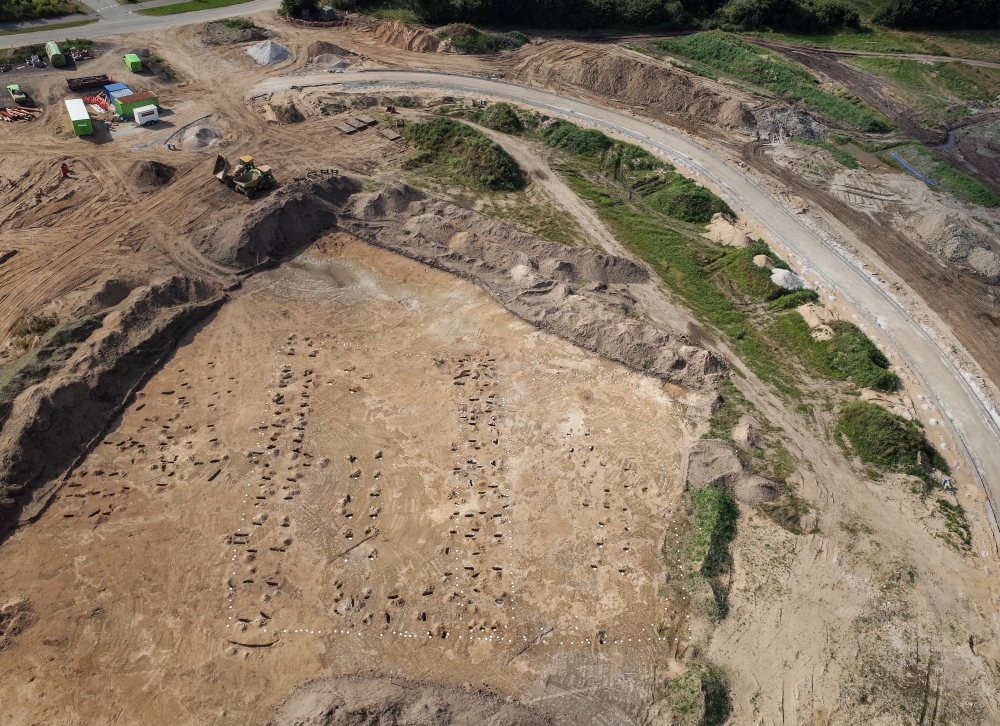Early Medieval Farming Village Unearthed Near Famed Viking Site

Archaeologists in Denmark have unearthed the remains of a 1,500-year-old farming village near the famed Viking site of Jelling in central Jutland.
The excavated village contains traces of up to 400 farm buildings, including several longhouses that would have each formed the center of a family farm.
Based on the distinctive shapes of the buildings, researchers have dated the remains to between A.D. 300 to 600 — a time known as the early medieval period in Europe, during the Germanic Iron Age in Denmark. [See Photos of the Remains of 1,500-Year-Old Farming Village]
"The carbon-14 dates will come later," said Katrine Balsgaard Juul, an archaeologist and curator with the Vejle Museums in southern Denmark, who led excavations at the site from October 2016 until this October. "We’ve taken soil samples from all the main houses, but they are still being processed." (Dating sediments using the carbon-14 isotope can offer more precise ages, the researchers noted.)
"But in Denmark we have a very long tradition of excavating early medieval settlements, so we are quite confident with the dates, even without the carbon-14 dating," she said.
The site at Jelling is the largest early medieval settlement unearthed in Denmark, although several smaller sites are well-known to archaeologists, such as those at Vorbasse in southern Denmark and at Nørre Snede, also in central Jutland, reported Science Nordic.
"The significance is in the size of the site — it makes it possible for us to test the knowledge that we already have," Balsgaard Juul told Live Science. "We have an idea of how the society developed at this time and how these villages developed, but now it is actually possible for us to test whether we can recognize these features in a large excavation such as this," she said.
Sign up for the Live Science daily newsletter now
Get the world’s most fascinating discoveries delivered straight to your inbox.
Post holes
Balsgaard Juul said the main features of the site were the thousands of post holes left by buildings constructed at different times during the 300-year period.
"We basically found 20,000 post holes, and that's quite a lot, especially for my colleague, who measured it all with a GPS," she said.
The position of many post holes showed that many buildings had been constructed on the same plots of land used by earlier buildings.
"It seems likely that there was some sort of core within this early medieval village, where the houses were rebuilt at least five times in a row," she said. "We usually say that these types of houses have a duration of at least 30 years, so it means that some areas of this village were inhabited for a very long time."
The ancient village included between eight and 10 longhouses at different times, each around 110 feet (33 meters) long and 18 feet (5.5 m) wide.
Each longhouse would have been the main building of a family farm, and home to between eight and 15 people, she said.
According to the traditions of the time, the villagers would have shared the longhouses with their animals: "We have the living area in one side of the house, and then in the middle of the house there's an entrance area, and on the other side there was a stable for animals and for whatever else you need for living in the [Germanic] Iron Age."
The villagers would have farmed crops in fields around their farmsteads, while the animals would have grazed on pastureland and in open forests nearby, Balsgaard Juul said.
Ancient farmsteads
In addition to the longhouses, hundreds of smaller outbuildings occupy the site. The smallest, around 6 by 6 feet (2 by 2 m), may have been granaries or storehouses, Balsgaard Juul said.
Others may have been working areas for making pottery or woolen fabric, she said.
They also found an area where iron-smelting ovens appeared to have been used at the time. The iron would have come from the ore-rich soil found in many bogs in Denmark, and one of the smaller buildings is thought to have been a smithy where the metal was worked. [Fierce Fighters: 7 Secrets of Viking Seamen]
The newly discovered village is about 0.6 miles (1 kilometer) from the UNESCO World Heritage site at Jelling, which features a historic church and two burial mounds from the Viking Age, along with the runic Jelling Stones placed by King Harald Bluetooth in the 10th century to mark the introduction of Christianity to his kingdom.
But Balsgaard Juul explained that the early medieval site was not directly connected with the later Viking Age developments.
Now that the excavations have been completed, the site will be developed into a modern village of about 40 houses, she said, but the memory of one of the ancient longhouses will be preserved.
"We have made plans with the city hall [to] mark out one of the [early medieval] houses on the site," Balsgaard Juul said. "We will make it visible above the ground where the post holes were, and then people can come and see where the actual village was situated in the early medieval period."
Original article on Live Science.
Tom Metcalfe is a freelance journalist and regular Live Science contributor who is based in London in the United Kingdom. Tom writes mainly about science, space, archaeology, the Earth and the oceans. He has also written for the BBC, NBC News, National Geographic, Scientific American, Air & Space, and many others.









